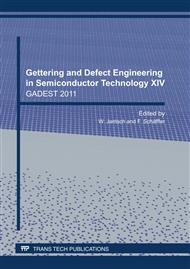p.43
p.50
p.56
p.61
p.67
p.72
p.79
p.88
p.94
Electrical Study of Self-Assembled Ge Quantum Dots Embedded in P-Type Silicon. Temperature Dependent Capacitance Voltage and DLTS Study
Abstract:
The electrical properties of dome-shaped and pyramid-shaped Ge Quantum Dots (QDs) embedded in p-type Silicon are reported. Capacitance-Voltage (T-CV) characteristics are reported for the temperature range of 35 K to 296 K. The T-CV results showed the desired charge carrier density of the Silicon, on the order of 1016 cm-3, at room temperature. Two shoulders are observed in the CV curves between 270 K and 175 K. They are explained as charge stored in the dome- and pyramid-shaped QDs. Below 175 K, only one shoulder is observed in the CV measurements, attributed to charge trapped in dome-shaped QDs. The DLTS study confirms these results. Using a reverse bias between -0.1 V and -1 V two peaks are seen at 50 and 70 K. They are explained in terms of the boron state (the one at 50 K) and charged stored on pyramid-shaped Ge QDs (the one at 70 K). Increasing the reverse bias from -1 V to -1.4 V shows the appearance of a peak around 60 K, attributed to dome-shaped Ge QDs. At the same time, a shoulder appears around 100 K for -1 V, which extends to larger temperatures as the reverse bias magnitude is increased. The activation energies found are around 50 meV (due to Boron), 150 to 250 meV (due to pyramid-shaped Ge QDs), 300 to 350 meV (due to dome-shaped Ge QDs) and 425 meV (due to both dome- and pyramid-shaped Ge QDs).
Info:
Periodical:
Pages:
67-71
Citation:
Online since:
August 2011
Authors:
Keywords:
Price:
Сopyright:
© 2011 Trans Tech Publications Ltd. All Rights Reserved
Share:
Citation:


